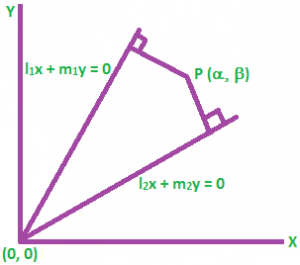Pair of straight lines – Theorem
Statement: The product of the perpendicular from (α, β) to the pair of lines ax² + 2hxy + by² = 0 is \(\frac{\left| a{{\alpha }^{2}}+2h\alpha \beta +b{{\beta }^{2}} \right|}{\sqrt{{{(a-b)}^{2}}+4{{h}^{2}}}}\).
Proof: Let ax² + 2hxy + by² = 0 … (1)

Represent lines l₁ x + m₁ y = 0 and l₂ x + m₂ y = 0
L₁L₂ = 0 represent a pair of straight line
(l₁ x + m₁ y) (l₂ x + m₂ y) = 0
l₁ l₂x² + m₁ m₂ y² + (l₁ m₂ + l₂ m₁) x y = 0 … (2)
compare equation 1 and 2 we get a, b and 2h
l₁ l₂ = a,
m₁ m₂ = b
and l₁ m₂ + l₂ m₁ = 2h
length of the perpendicular from (α, β) to l₁ x + m₁ y = 0
\(P=\frac{\left| {{l}_{1}}\alpha +{{m}_{1}}\beta \right|}{\sqrt{{{l}_{1}}^{2}+{{m}_{1}}^{2}}}\).
Length of the perpendicular from (α, β) to l₂ x + m₂ y = 0
\(q=\frac{\left| {{l}_{2}}\alpha +{{m}_{2}}\beta \right|}{\sqrt{{{l}_{2}}^{2}+{{m}_{2}}^{2}}}\).
The product of the perpendicular from (α, β) to the pair of lines ax² + 2hxy + by² = 0 is
\(pq=\frac{\left| {{l}_{1}}\alpha +{{m}_{1}}\beta \right|}{\sqrt{{{l}_{1}}^{2}+{{m}_{1}}^{2}}}.\frac{\left| {{l}_{2}}\alpha +{{m}_{2}}\beta \right|}{\sqrt{{{l}_{2}}^{2}+{{m}_{2}}^{2}}}\),
\(pq=\frac{\left| {{l}_{1}}{{l}_{2}}{{\alpha }^{2}}+{{m}_{1}}{{m}_{2}}{{\beta }^{2}}+({{l}_{1}}{{m}_{2}}+{{l}_{2}}{{m}_{1}})\alpha \beta \right|}{\sqrt{({{l}_{2}}^{2}+{{m}_{2}}^{2})({{l}_{1}}^{2}+{{m}_{1}}^{2})}}\),
\(pq=\frac{\left| {{l}_{1}}{{l}_{2}}{{\alpha }^{2}}+{{m}_{1}}{{m}_{2}}{{\beta }^{2}}+({{l}_{1}}{{m}_{2}}+{{l}_{2}}{{m}_{1}})\alpha \beta \right|}{\sqrt{{{l}_{1}}^{2}{{l}_{2}}^{2}+{{l}_{1}}^{2}{{m}_{2}}^{2}+{{m}_{1}}^{2}{{l}_{2}}^{2}+{{m}_{1}}^{2}{{m}_{2}}^{2}}}\),
\(pq=\frac{\left| {{l}_{1}}{{l}_{2}}{{\alpha }^{2}}+{{m}_{1}}{{m}_{2}}{{\beta }^{2}}+({{l}_{1}}{{m}_{2}}+{{l}_{2}}{{m}_{1}})\alpha \beta \right|}{\sqrt{{{({{l}_{1}}{{l}_{2}}+{{m}_{1}}{{m}_{2}})}^{2}}-2{{l}_{1}}{{l}_{2}}{{m}_{1}}{{m}_{2}}+{{({{l}_{1}}{{m}_{2}}+{{l}_{2}}{{m}_{1}})}^{2}}+2{{l}_{1}}{{l}_{2}}{{m}_{1}}{{m}_{2}}}}\),
\(pq=\frac{\left| {{l}_{1}}{{l}_{2}}{{\alpha }^{2}}+{{m}_{1}}{{m}_{2}}{{\beta }^{2}}+({{l}_{1}}{{m}_{2}}+{{l}_{2}}{{m}_{1}})\alpha \beta \right|}{\sqrt{{{({{l}_{1}}{{l}_{2}}+{{m}_{1}}{{m}_{2}})}^{2}}+{{({{l}_{1}}{{m}_{2}}+{{l}_{2}}{{m}_{1}})}^{2}}}}\).
We know that l₁ l₂ = a, m₁ m₂ = b, l₁ m₂ + l₂ m₁ = 2h these values are substitute above equation.
\(pq=\frac{\left| a{{\alpha }^{2}}+2h\alpha \beta +b{{\beta }^{2}} \right|}{\sqrt{{{(a+b)}^{2}}+{{(2h)}^{2}}}}\),
\(pq=\frac{\left| a{{\alpha }^{2}}+2h\alpha \beta +b{{\beta }^{2}} \right|}{\sqrt{{{(a+b)}^{2}}+4{{h}^{2}}}}\).
Hence proved the product of the perpendicular from (α, β) to the pair of lines ax² + 2hxy + by² = 0 is \(\frac{\left| a{{\alpha }^{2}}+2h\alpha \beta +b{{\beta }^{2}} \right|}{\sqrt{{{(a-b)}^{2}}+4{{h}^{2}}}}\).
Example: The product of the perpendicular from (1, 2) to the pair of lines 2x² – xy + y² = 0 is
Solution: Given that
2x² – xy + y² = 0 and (1, 2)
Where a = 2, b = 1 and h= -½
We know that the product of the perpendicular from (α, β) to the pair of lines ax² + 2hxy + by² = 0 is \(\frac{\left| a{{\alpha }^{2}}+2h\alpha \beta +b{{\beta }^{2}} \right|}{\sqrt{{{(a-b)}^{2}}+4{{h}^{2}}}}\),
= \(\frac{\left| 2{{x}^{2}}-xy+{{y}^{2}} \right|}{\sqrt{{{(2-1)}^{2}}+4{{\left( \frac{-1}{2} \right)}^{2}}}}\) ,
= \(\frac{\left| 2{{(1)}^{2}}-(1)(2)+{{(2)}^{2}} \right|}{\sqrt{{{(2-1)}^{2}}+4\left( \frac{1}{4} \right)}}\),
= \(\frac{\left| 2-2+4 \right|}{\sqrt{1+1}}\),
= 2√2.
